Who doesn’t love a good caper? I have always loved heists in any form, from old movies like To Catch a Thief, to noir films about gangs getting together for one last job, to true-crime books about the Brinks Job or Murph the Surf burglarizing the Museum of Natural History. And in the hands of the right novelist, a heist story is a wonder of narrative art, combining Swiss-watch construction with deceit and disaster, things going stunningly right and wildly wrong. They are galleries full of great characters. They have the jazz player’s sense of theme and variation. They are funny. And best of all, they are about criminals. If, as Adorno says, every work of art is an uncommitted crime, than the heist novel is, in the end, a story about artists at work.
I suppose it was inevitable that I would try to pull off a caper of my own, and the books on this list were some of the favorites I pondered when writing The Bouncer. It’s true that the heist novel seems to garner less respect in high literary circles than say, its sister sub-genre, the detective story. But two groups admire them endlessly—readers and writers. Readers because they are, at their best, pure joy. Writers because they are pure hell. Writers read books like these in delight and despair. How did they pull that dazzling stunt off, one more time?

Chester Himes, Cotton Comes to Harlem
Chester Himes is a great American writer, best known for his series of crime novels about two Harlem detectives, Coffin Ed and Gravedigger Jones. His writing combines absolutely authoritative realism with totally over-the-top, savage satire and imagery and characters bordering on the surreal in a manner that was totally new to me. In the opening scene of Cotton Comes to Harlem, a back-to-Africa rally, engineered by black con men, is hijacked by white bandits, who steal the 87 grand collected and trigger a riot. And that’s just for starters. The action is tremendous, the characters outrageous, and the block-by-block descriptions of Harlem’s streets, joints, food, speech, clothes, music and people are astonishing, especially when you find out that he lived most of his writing life as an expat in France. Himes’s Harlem is like Joyce’s Dublin—the place that broke his heart, that he never wanted to go back to, but that he couldn’t stop writing about in endless detail, full of love, rage and despair.
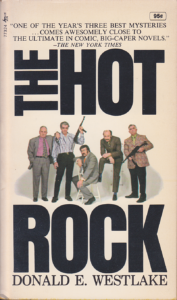
Donald Westlake, The Hot Rock
If the heist novel has a god, it is Westlake. He so dominates the form that he appears on this list twice. We’re talking about a guy who counts Elmore Leonard and Lawrence Block among his fans. The Hot Rock showcases Westlake in his comic mode, with the first of the Dortmunder novels, a series about the daring but rarely successful escapades of an ingenious, hopelessly unlucky criminal and his crew. Here, in a brilliant conceit, they end up having to steal the same stone over and over, from more and more precarious locations, including a police station. One of the hallmarks of the form that we see here is sympathy with the eternal outsider as hero. Dortmunder would rather risk life in prison than get a day job. What writer can’t relate to that?
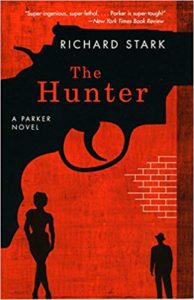
Richard Stark, The Hunter
Westlake again, writing under an alias, and with the character of Parker, who drives these propulsive tales relentlessly, remorselessly and inexorably forward, he produces perhaps the most highly-regarded heist series in literature. He is a virtuoso of plot construction. Once I start reading, I pretty much can’t stop. And then there’s Parker, the criminal’s criminal, the ultimate noir figure. Even to speak of anti-heroes feels off target. Like a tiger in the jungle, Parker is neither good nor evil, though he is, at times, a creature of beauty in action. I put the series opener up here, in which Parker, double-crossed and left for dead, pursues a debt from the mob in New York, but if anything, this series gets better as it goes along.
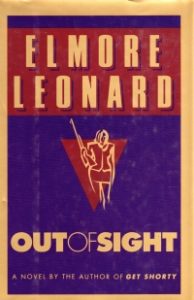
Elmore Leonard, Out of Sight
My admiration for Elmore Leonard is such that as a teenager, I named my first protagonists, Elmore, Elwood, Elvin and finally Leonard. In this one, imperturbably cool bank robber Jack Foley escapes from prison, but ends up locked in a trunk with Federal Marshal Karen Sisco. Leonard’s great ear for dialogue and deep sense of place and time give his books a unique feeling: the character-driven caper novel, in which, much like life, all our plans and plots confound and complicate each other in seemingly random ways. But like a pool hustler pulling off a sweet trick, all the balls ricochet off of each other and fall, elegantly, into perfect place.

Jim Thompson, The Getaway
Here the heist novel becomes a journey to the heart of noir darkness, as the classic pulp artist spins the tale of ace bank robber Doc McCoy and his wife Carol. Their path, from jail to job to a run for the border, is littered with double-crosses and betrayals, and ends in a symbolic hell where, inevitably, those who live by crime and deceit are doomed to devour each other. Also made into the awesome Steve McQueen/Ali McGraw movie by the equally great and grim Sam Peckinpah.
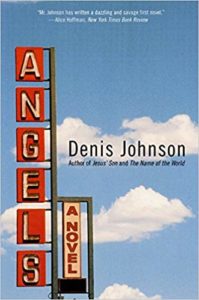
Denis Johnson, Angels
Heist as tragedy. By the author of Jesus’ Son, this is another profoundly powerful book from a writer we recently lost. In Angels, a gang of desperate souls gather for the planning, execution and aftermath of a bank robbery which goes horribly and hideously wrong, becoming a story of degradation, despair and perhaps, if redemption is unthinkable, then a kind of spiritual realization. Fair warning: I gave this book to someone who read it on a plane and she ended up weeping openly in public.
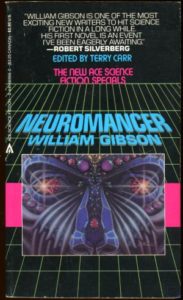
William Gibson, Neuromancer
One of those books that changes the form: the trope of the washed-up pro criminal being recruited for one last job is transported into the future, circa 1984, thereby helping spawn the world of cyber-punk and everything that follows, down to The Matrix and beyond. It was also, for me at least, one of the first instances of the hacker as hero. Now that character is a necessity on any crew pulling a job. I’m also a big fan of genre-mixing generally, amongst popular forms and across the supposedly high-low literary line—I even teach a class in it. Here the heist story is used to invigorate sci-fi, and vice versa.

P.G. Wodehouse, The Code of the Woosters
A bit of a curveball, I know, or better yet a screwball, but farce shares a lot with the heist story: a plan is concocted to achieve some goal and immediately goes wrong, necessitating a new plan and so on, into glorious delirium. Bertie and his gentleman’s gentleman Jeeves are constantly conspiring to steal or retrieve treasured objects —in this case a coveted silver cow creamer—and their schemes involve all manner of disguises, impersonations, and climbing over walls and into windows while evading the cops, though the stakes, and the body count, are admittedly quite a bit lower. Read this as a refreshing break between the others, and meet the Maestro. There is no one better.

David Maurer, The Big Con
This is not a novel, nor is it about a heist per se, but this book is a true treasure for anyone interested in the subject. Maurer was not even a fiction writer. He was a linguist, studying underworld slang in the 1930s. He found, however, that the language of con men was so insular and opaque that he had to describe how they pulled off their capers as well. It became an inspiration for the movie, The Sting (or so Maurer claimed in a settled lawsuit), but for me its main pleasure is its exploration of a doubly lost subculture—an underground whose members are all dead and buried—that still influences language and culture today. These wise guys were already saying “fly,” and “suckers” and “the bomb,” way back in the 20s. My personal favorite: referring to normal folk, civilians, as “savages.” In their world, they are the true aristocrats.

Jack Higgins, The Eagle Has Landed
I decided to end with this because it is both an interesting take on the form and exactly the kind of thrilling, suspenseful, high-spirited adventure that drew me to the caper book in the first place. Set during WWII, it concerns a German plot to, get this, kidnap Winston Churchill. The outlandishness of that scheme is only the beginning, but the intricate plan, the twists, crises, and daring solutions are expertly woven into real history—just the thing to capture the imagination of the fourteen-year-old in us all. It also blends the heist story with the espionage tale, something which I have humbly attempted, in my own way, in The Bouncer.

















